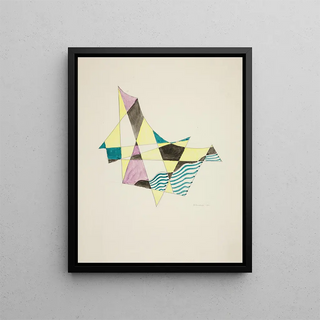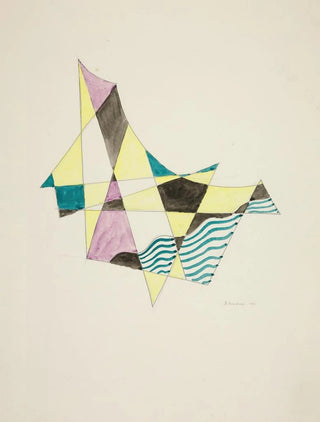Abstract Painting based on Sails X - David Kakabadze | Art print


View from behind

Frame (optional)
Art print Abstraction based on Sails X - David Kakabadze – Captivating Introduction
The artwork "Abstraction based on Sails X" by David Kakabadze stands as a true ode to modernity and the exploration of forms. In this piece, the Georgian artist skillfully merges elements of abstraction with references to nature and the sea, creating a captivating visual dialogue. This art print, both vibrant and evocative, invites viewers to immerse themselves in a universe where color and form meet to give rise to a unique aesthetic experience. Kakabadze, through his bold approach, encourages us to reevaluate our perception of the world around us, while offering a window into his own imagination.
Style and uniqueness of the work
The piece is distinguished by its daring use of color and geometric shapes. The vibrant hues, ranging from deep blues to bright reds, evoke the reflections of light on the sails of boats. Each brushstroke seems to capture the movement of water and the breath of the wind, making the work almost alive. Kakabadze plays with space and composition, creating a balance between abstraction and representation. This unique style, both dynamic and poetic, reflects the influence of avant-garde currents of the early 20th century, while maintaining an artist’s own identity. The juxtaposition of angular shapes and fluid curves creates a visual tension that intrigues and fascinates, inviting the viewer to explore the multiple layers of meaning present in the work.
The artist and his influence
David Kakabadze, an emblematic figure of Georgian art, managed to mark his era with his innovative vision and commitment to modern art. Born in 1889, he was influenced by European artistic movements, while remaining deeply rooted in his cultural origins. Kakabadze played a decisive role in introducing abstraction in Georgia, merging traditional elements with modern techniques. His work is often seen as a reflection of his desire to harmonize the past and the present, while exploring universal themes of nature and humanity.

Matte finish

View from behind

Frame (optional)
Art print Abstraction based on Sails X - David Kakabadze – Captivating Introduction
The artwork "Abstraction based on Sails X" by David Kakabadze stands as a true ode to modernity and the exploration of forms. In this piece, the Georgian artist skillfully merges elements of abstraction with references to nature and the sea, creating a captivating visual dialogue. This art print, both vibrant and evocative, invites viewers to immerse themselves in a universe where color and form meet to give rise to a unique aesthetic experience. Kakabadze, through his bold approach, encourages us to reevaluate our perception of the world around us, while offering a window into his own imagination.
Style and uniqueness of the work
The piece is distinguished by its daring use of color and geometric shapes. The vibrant hues, ranging from deep blues to bright reds, evoke the reflections of light on the sails of boats. Each brushstroke seems to capture the movement of water and the breath of the wind, making the work almost alive. Kakabadze plays with space and composition, creating a balance between abstraction and representation. This unique style, both dynamic and poetic, reflects the influence of avant-garde currents of the early 20th century, while maintaining an artist’s own identity. The juxtaposition of angular shapes and fluid curves creates a visual tension that intrigues and fascinates, inviting the viewer to explore the multiple layers of meaning present in the work.
The artist and his influence
David Kakabadze, an emblematic figure of Georgian art, managed to mark his era with his innovative vision and commitment to modern art. Born in 1889, he was influenced by European artistic movements, while remaining deeply rooted in his cultural origins. Kakabadze played a decisive role in introducing abstraction in Georgia, merging traditional elements with modern techniques. His work is often seen as a reflection of his desire to harmonize the past and the present, while exploring universal themes of nature and humanity.
12,34 €






